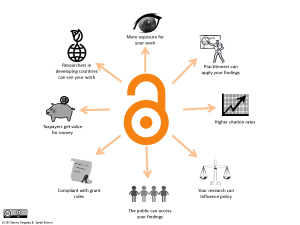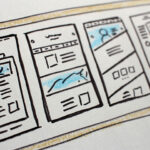By Lilian Nassi-Calò

Image: Danny Kingsley and Sarah Brown.
The Workshop on Alternative Open Access Publishing Models organized by the European Commission in October 2015 brought together science communication specialists at its headquarters in Brussels to discuss the future of open access (OA). Posts previously published on this blog reported the objectives of the meeting, as well as institutional approaches and potentially sustainable business models, given the growing number of open access mandates in the European Union and the world, especially for publicly funded research results.
The ways to enable open access business models and ideas conveyed in the workshop are listed below. Some are common to more than one proposal, indicating that the models have good possibilities to be sustainable and successful, according to the report written by Adam Smith1.
Partnership
Cooperation between different actors in open access publishing, such as scholars, editors, librarians and publishers, strengthens this business model and contributes to weaken the traditional subscription systems.
For example, it is common for libraries to obtain better subscription prices through packages of several journals from a particular publisher. However, non-disclosure agreements which they are required to sign forbid libraries to share this information. Gerard Meijer, president of the Radboud University (The Netherlands), calls academic institutions to refuse to sign such agreements from now on, since they only benefit publishers.
The Open Library of Humanities (OLH) and the Open Access Network are fighting the requirement for confidentiality between publishers and institutions. OLH, as a publishing platform, encourages the free exchange of information and collaboration between libraries. The Open Access Network also advocates sharing of information, resources and objectives.
SciELO is the most established system between the models discussed at the meeting, according to Adam Smith. It is a 17 year old partnership that increases the visibility of open access research results through shared publishing, indexing and dissemination systems. The report also mentions that SciELO is to become a large scale publisher and, thus, stimulates the partnership between journals, confronting the traditional publishing model.
Vertical openness
Open access in scientific publishing has as primary objective the visibility of the research results and its wide availability to any interested person, which can be characterized as a form of ‘horizontal openness’, a term used by Adam Smith in the AlterOA workshop report.
In contrast, ‘vertical openness’ refers to data sharing. The availability of research data on open access repositories and journals (open data) has been gaining momentum among the scholarly community and other sectors of society. Numerous initiatives created in recent years seek to encourage this practice, and resolve ethical and technological issues related to data sharing. The use, reuse, review, discussion and citation of research data led to significant changes in the practice of scientific publishing. Research data complement the traditional paper, but it does not replace it. However, the journal loses exclusivity on reporting results which, over time, may diminish its relevance. Data sharing is particularly interesting for funding agencies as they increase the transparency of research and inform how the resources are being employed. Preprint repositories such as arXiv and BioRxiv can be considered examples of vertical openness, since they share with journals the exclusivity of discovery.
The developing initiative Open Research Network, when creating non-commercial alternatives to publication and dissemination of research results and data preservation, is another example of vertical openness.
Tension over profit
Although most open access initiatives are non-for-profit, OA is actually compatible with profit. Commercial open access publishers, such as PLoS and BioMed Central, however, seek to encourage some authors with reduced article processing charges (APCs) and operate with much lower profit margins than the large multinational publishers such as Elsevier, Springer and Wiley, of about 30-40%. To oppose them and their disproportionate profits came several OA models that advocate zero or very low profits that, for this reason, are more likely to be supported by the scholarly community.
A representative of this business model is the Open Library of Humanities, which believes that profit is not needed to be successful in the publishing market. For OLH and many others, research results are seen as a public good and should be freely accessible. The University College London Press shares this idea and employs the institution’s public resources to finance OA publishing without APCs for UCL authors and through a small fee for authors from other institutions. In the same vein are the SCOAP3 project led by CERN and the Pay-what-you-want model of the University of Munich.
The changing role of the state
The mandates of certain funding agencies, mainly public, demand OA publication of the research results they fund. If on the one hand governments have to stimulate innovation, business and economic growth through initiatives that aim to profit, when funding research, funders who look to maximize the visibility and impact of the resources used, tend to support OA non-for-profit business models. Consequently, public funding agencies in many countries have had a strong impact on the growth and strengthening of open access.
Research councils in the UK and the Higher Education Funding Council for England promoted a radical change in the scholarly publishing conduct through policies that require open access. Likewise, the European Commission (EC), even before establishing the rules for Horizon 2020, already reported that the proportion of OA articles was over 50% in 2011. The report also highlights SciELO, as an initiative that uses public resources to subsidize OA publishing and is to become a well-established, efficient and influential regional publisher.
The apparent contradiction mentioned above, in fact, is not a conflict. By making research results open access, there is an incentive to innovation for the benefit of all. The monopoly of commercial publishers, however, tends to decrease with the advancement of technology and policy change in favor of open access.
The growing importance of research libraries
As OA strengthens, the role of research libraries is no longer limited to the decision on journals subscriptions and as information providers, and acquires greater participation and importance. The OLH is one of the initiatives that empower librarians to act as collaborative publishers to find alternative solutions to face increased subscription prices and other issues.
Conclusions
AlterOA showed that innovating ideas and technology is the driving force that moves open access as a business model in scholarly publishing. The EC considers that there is still much to be done and enumerates the following three steps:
- Continue to gather views and ideas from researchers, funders, librarians and users of scientific research to be discussed at an upcoming event, possibly in 2016.
- Obtain seed funding to promote alternative open access models until they become established and sustainable.
- Improve the open access mandate for Horizon 2020 to promote certain OA business models and discourage others that are not favorable.
The EC intends to maximize transparency and participation and encourages interested parties to express their views and ideas through the Digital4Science platform.
Note
1. Report of the Workshop on Alternative Open Access Publishing Models. European Commission. 2015. Available from: http://ec.europa.eu/digital-agenda/en/news/report-workshop-alternative-open-access-publishing-models
References
NASSI-CALÒ, L. European Commission debates alternative approaches to open access. SciELO in Perspective. [viewed 09 January 2016]. Available from: http://blog.scielo.org/en/2016/01/06/european-commission-debates-alternative-approaches-to-open-access/
NASSI-CALÒ, L. Open access as a sustainable alternative to scholarly communication. SciELO in Perspective. [viewed 09 January 2016]. Available from: http://blog.scielo.org/en/2016/01/14/open-access-as-a-sustainable-alternative-to-scholarly-communication/
NASSI-CALÒ, L. Project Making Data Count encourages sharing of research data. SciELO in Perspective. [viewed 10 January 2016]. Available from: http://blog.scielo.org/en/2015/10/01/project-making-data-count-encourages-sharing-of-research-data/
PATTERSON, M. Meeting considers how open access could address inequalities – Originally published in Research Information on October 19, 2014. SciELO in Perspective. [viewed 10 January 2016]. Available from: http://blog.scielo.org/en/2014/10/19/meeting-considers-how-open-access-could-address-inequalities/
Report of the Workshop on Alternative Open Access Publishing Models. European Commission. 2015. Available from: http://ec.europa.eu/digital-agenda/en/news/report-workshop-alternative-open-access-publishing-models
SCIENTIFIC ELECTRONIC LIBRARY ONLINE. The Open Data movement: international consolidation. SciELO in Perspective. [viewed 10 January 2016]. Available from: http://blog.scielo.org/en/2014/07/14/the-open-data-movement-international-consolidation/
SPINAK, E. and PACKER, A. Scientific Data: Nature Publishing Group moves the communication of scientific data forward with its new online open access publication. SciELO in Perspective. [viewed 10 January 2016]. Available from: http://blog.scielo.org/en/2014/02/04/scientific-data-nature-publishing-group-moves-the-communication-of-scientific-data-forward-with-its-new-online-open-access-publication/
SPINAK, E. International Open Data Week – what’s new?. SciELO in Perspective. [viewed 10 January 2016]. Available from: http://blog.scielo.org/en/2015/01/07/international-open-data-week-whats-new/
External links
arXiv – <http://arxiv.org/>
BioMed Central – <http://www.biomedcentral.com/>
BioRxiv – <http://biorxiv.org/>
Digital4Science – <http://ec.europa.eu/futurium/en/content/what-future-open access-publishing>
Horion 2020 – <http://ec.europa.eu/programmes/horizon2020/>
OLH – <http://www.openlibhums.org/>
Open access Network – <http://openaccessnetwork.org/>
Pay What You Whant – <http://www.en.uni-muenchen.de/news/spotlight/2015_articles/spann_paywhatyouwant.html>
PLoS – <http://www.plos.org/>
SciELO – <http://www.scielo.org/>
SCOPA3 – <http://scoap3.org/>
UCL Press – <http://www.ucl.ac.uk/ucl-press>
 About Lilian Nassi-Calò
About Lilian Nassi-Calò
Lilian Nassi-Calò studied chemistry at Instituto de Química – USP, holds a doctorate in Biochemistry by the same institution and a post-doctorate as an Alexander von Humboldt fellow in Wuerzburg, Germany. After her studies, she was a professor and researcher at IQ-USP. She also worked as an industrial chemist and presently she is Coordinator of Scientific Communication at BIREME/PAHO/WHO and a collaborator of SciELO.
Translated from the original in portuguese by Lilian Nassi-Calò.
Como citar este post [ISO 690/2010]:

















Recent Comments